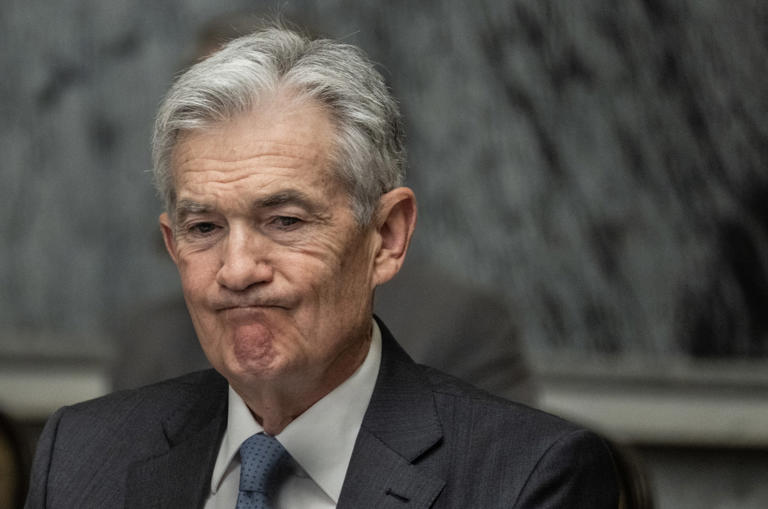Federal Reserve Chairman Jerome Powell is facing one of the most intricate communication challenges of his tenure this week, as investors and market analysts closely scrutinize the central bank’s interest rate strategy. This scrutiny comes after an unusually lengthy period during which the Fed refrained from changing its key lending rates, creating heightened anticipation around the Fed’s next moves.
The current federal funds rate stands at 5.25% to 5.5%, a level not seen in two decades. Powell’s task is to navigate a delicate balance: he must indicate whether the Fed plans to implement a rate cut in September while simultaneously justifying why such a move is not being made immediately. This balancing act is crucial as the central bank has managed to maintain a relatively steady course despite various economic signals and market fluctuations throughout the year.
The backdrop to this situation is a volatile shift in market expectations regarding Fed rate cuts. Earlier in the year, there were strong predictions that the Fed might reduce rates up to four times in 2024, based on initial signs of slowing economic growth and moderating inflation. However, the economic landscape has since evolved. Persistent inflation, coupled with a resilient labor market and stronger-than-expected GDP growth, has tempered those expectations. These factors have kept Treasury bond yields elevated and supported a strong U.S. dollar, which has risen against other major currencies.
Recently, however, new economic data has introduced a shift in sentiment. June’s Consumer Price Index (CPI) report was relatively benign, and there have been signs of a slowing labor market and waning consumer sentiment. These indicators have fueled speculation that the Federal Reserve might be poised to initiate its first rate cut of the year in September. Powell is set to address these expectations during his press conference on Wednesday at 2:30 p.m. Eastern Time, a moment that will likely be closely analyzed for signals regarding the Fed’s future policy direction.
Powell’s challenge is further complicated by the need to justify why a rate cut is not being implemented immediately while still keeping the door open for future reductions. Analysts, including Bryce Doty from Sit Investment Associates, point out that it will be challenging for Powell to manage this messaging. He must articulate the rationale for holding rates steady now while hinting at the potential for a rate cut in the near future. This task is particularly difficult given that the core Personal Consumption Expenditures (PCE) inflation rate—the Fed’s preferred measure—has fallen to around 1.5%, well below the Fed’s 2% target.
On the other side of the argument, there are compelling reasons for the Fed to hold off on an immediate rate cut. The economy grew at a stronger-than-expected rate of 2.8% last quarter, and job market data, while showing some softening, still reflects a tight labor market with approximately 8.18 million job openings. This ongoing economic strength and tight labor market present significant counterpoints to the case for immediate rate reductions.
Jason Pride of Glenmede notes that while the Fed has successfully managed to control inflation without triggering a recession, the situation is evolving. If inflationary pressures continue to ease, the Fed may need to adopt a more balanced approach, taking into account the potential negative effects of a prolonged period of tight monetary policy on economic growth and stability.
The Fed’s current position puts it in a difficult spot. Waiting until September to cut rates introduces the risk of falling behind the curve if economic conditions worsen more rapidly than anticipated. Conversely, acting now could signal to investors that the Fed perceives deeper economic issues that are not yet apparent, potentially leading to market concerns and volatility.
Bret Kenwell of eToro highlights that an unexpected rate cut this week could lead to a negative market reaction. Investors might interpret such a move as a sign that the Fed sees more severe economic deterioration than currently understood, potentially prompting a sell-off in equity markets.
Richard Ratner from Bel Air Investment Advisors emphasizes the importance of Powell’s communication in shaping market reactions. If Powell adopts a hawkish stance, it could lead to markets pricing out the possibility of a September rate cut, causing a decline in equity markets due to weakened investor sentiment.
Conversely, Doty views any market pullback from a hawkish Fed stance as a potential buying opportunity. He argues that a slower pace in reducing interest rates could necessitate more aggressive cuts later if economic conditions continue to deteriorate, providing a strategic opportunity for long-term investors.
Currently, the markets are pricing in expectations for three rate cuts by the end of the year, with the Federal Funds rate anticipated to fall to 4.625% by December. If the Fed initiates a rate cut in September, it would mark the longest stretch between the last rate hike and the next reduction, aligning with the “catch-up” theory.
Goldman Sachs, which had previously forecast no changes in the Federal Funds rate until 2025, has recently revised its outlook to expect at least two rate cuts by the end of the year. This adjustment reflects shifting economic dynamics and underscores the challenges faced by the Federal Reserve in managing monetary policy amid evolving economic indicators and market expectations.
